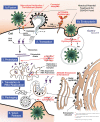COVID-19: Review of a 21st Century Pandemic from Etiology to Neuro-psychiatric Implications
- PMID: 32925078
- PMCID: PMC7592693
- DOI: 10.3233/JAD-200831
COVID-19: Review of a 21st Century Pandemic from Etiology to Neuro-psychiatric Implications
Abstract
COVID-19 is a severe infectious disease that has claimed >150,000 lives and infected millions in the United States thus far, especially the elderly population. Emerging evidence has shown the virus to cause hemorrhagic and immunologic responses, which impact all organs, including lungs, kidneys, and the brain, as well as extremities. SARS-CoV-2 also affects patients', families', and society's mental health at large. There is growing evidence of re-infection in some patients. The goal of this paper is to provide a comprehensive review of SARS-CoV-2-induced disease, its mechanism of infection, diagnostics, therapeutics, and treatment strategies, while also focusing on less attended aspects by previous studies, including nutritional support, psychological, and rehabilitation of the pandemic and its management. We performed a systematic review of >1,000 articles and included 425 references from online databases, including, PubMed, Google Scholar, and California Baptist University's library. COVID-19 patients go through acute respiratory distress syndrome, cytokine storm, acute hypercoagulable state, and autonomic dysfunction, which must be managed by a multidisciplinary team including nursing, nutrition, and rehabilitation. The elderly population and those who are suffering from Alzheimer's disease and dementia related illnesses seem to be at the higher risk. There are 28 vaccines under development, and new treatment strategies/protocols are being investigated. The future management for COVID-19 should include B-cell and T-cell immunotherapy in combination with emerging prophylaxis. The mental health and illness aspect of COVID-19 are among the most important side effects of this pandemic which requires a national plan for prevention, diagnosis and treatment.
Keywords: Actemra; Alzheimer’s disease; Avigan; COVID-19; COVID-19 Neurological implications; COVID-19 Alzheimer’s Disease and dementia; COVID-19 Clinical manifestations; COVID-19 Convalescent plasma; COVID-19 Janus Kinase Inhibitor 1 and 2; COVID-19 Natural Killer Cells and stem cell therapy; COVID-19 Nutrition; COVID-19 Rehabilitation; COVID-19 Risk factors and comorbidities; COVID-19 Screening; COVID-19 Steroids; COVID-19 Vaccines; COVID-19 air filtration; COVID-19 anticoagulants; COVID-19 antiviral; COVID-19 complications; COVID-19 diagnostics; COVID-19 domestic abuse; COVID-19 immunotherapy; COVID-19 mental disorders; COVID-19 monoclonal antibodies; COVID-19 ophthalmology; COVID-19 test; Hydroxychloroquine; Nanomedicine for COVID-19; Remdesivir; SARS-CoV-2; SARS-CoV-2 treatment; coronavirus; mental health.
Conflict of interest statement
Authors’ disclosures available online (
Figures








References
-
- World Health Organization, Coronavirus disease (COVID-19) Situation Report – 191, https://www.who.int/docs/default-source/coronaviruse/situation-reports/2..., Last Update 29 July 2020, Accessed 29 July 2020.
-
- CDC, Demographic Trends of COVID-19 cases and deaths in the US reported to CDC, https://www.cdc.gov/covid-data-tracker/#demographics, Last Update 27 June 2020, Accessed 27 June 2020.
-
- CDC, Characteristics of Persons Who Died with COVID-19 — United States, February 12–May 18, 2020, Last Update 17 July 2020, Accessed 27 July 2020. - PubMed
-
- Heald-Sargent T, Muller WJ, Zheng X, Rippe J, Patel AB, Kociolek LK (2020) Age-related differences in nasopharyngeal severe acute respiratory syndrome coronavirus 2 (SARS-CoV-2) levels in patients with mild to moderate coronavirus disease 2019 (COVID-19), JAMA Pediatr, doi: 10.1001/jamapediatrics.2020.3651 - DOI - PMC - PubMed
Publication types
MeSH terms
Grants and funding
LinkOut - more resources
Full Text Sources
Other Literature Sources
Miscellaneous

